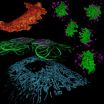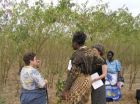(Press-News.org) BOSTON – It has been more than 50 years since Rachel Carson published her groundbreaking book Silent Spring. Regarded as a hero by some and a villain by others, Carson helped revolutionize the way the public views environmental science.
One area of Carson's career that is often overlooked is her time as a government employee. This is where she got her true start in journalism and it is the area G. Pascal Zachary, professor of practice with the Consortium for Science, Policy and Outcomes at Arizona State University, will be discussing at the 2013 American Association for the Advancement of Science (AAAS) annual meeting in Boston. Zachary is part of the panel, A 50 Year Legacy: Why does Rachel Carson Matter?
Zachary, who co-organized the panel along with ASU professor Jane Maienschein, gave his talk, "Back to the Future: The Rachel Carson 'Model' as a Response to the Crisis in Science Journalism," today (Feb. 17).
"At a time when popular writers wanted to write about serious subjects and devote themselves to learning, there was little support for them commercially," Zachary said on Carson and her early career. "I'm intrigued about how her career suggests a way forward for government to support serious writing and journalism about science and the environment."
Carson served as an information officer with the U.S. Bureau of Fisheries and the Fish and Wildlife Service for nearly two decades before becoming an independent writer. During that time, she reported on news and findings from the agency.
Zachary believes Carson's experience and work in this field is what shaped her later writings. Additionally, he saw her early government work as an opportunity. With publications such as the New York Times recently disposing of their environmental desk, Zachary thinks the format of having government employees writing about science could be the way of the future.
"I'm trying to see Rachel Carson in both a historical sense and prefiguring and anticipating a movement that will reform or revolutionize science journalism today," Zachary said.
"When I talk about her as a model for the crisis in science journalism, what I mean is currently there is less and less quality science journalism," he added. "As a community, we have to figure out how to draw the line and get a minimal amount of quality science journalism."
###
Media contacts:
Jennifer Snyder, CSPO, (480) 584-9591
Skip Derra, (480) 965-4823; skip.derra@asu.edu
ASU professor sees Rachel Carson's early careers as a model for today's science journalism crisis
2013-02-17
ELSE PRESS RELEASES FROM THIS DATE:
Key to cleaner environment may be right beneath our feet
2013-02-17
UNIVERSITY PARK, Pa. -- While many people recognize that clean water and air are signs of a healthy ecosystem, most do not realize that a critical part of the environment is right beneath their feet, according to a Penn State hydrologist.
The ground plays an important role in maintaining a clean environment by serving as a natural water filtration and purification system, said Henry Lin, professor of hydropedology and soil hydrology. Understanding the components that make up this integral part of the ecosystem can lead to better groundwater management and smarter environmental ...
Evidence shows concussions require long-term follow-up for players
2013-02-17
February 17, 2013 – Boston, MA - As the National Football League braces for lawsuits by 4000 former players alleging the league failed to protect them from the long-term consequences of concussions, game-changing research by a leading Canadian researcher shows damage to the brain can persist for decades after the original head trauma.
"Even when you are symptom-free, your brain may still not be back to normal," says Dr. Maryse Lassonde, a neuropsychologist and the scientific director of the Quebec Nature and Technologies Granting Agency.
Lassonde, whose work is supported ...
ArcticNet recommends practical solutions to improve standard of living in Canada's north
2013-02-17
February 17, 2013 - Boston, MA – Northern communities are in the midst of a period of intense and rapid change brought on by modernization, industrialization and the realities of climate change. From preserving the means to hunt caribou to protecting stocks of arctic char - balancing development with a respect and preservation of traditional means of sustainability may be key to improving standards of living in the North.
With the help of the icebreaker Amundsen, Louis Fortier, Canada Research Chair on the Response of Arctic Marine Ecosystems to Climate Change and other ...
Canada's top water expert brings lessons on water resource management to AAAS
2013-02-17
February 17, 2013 — Boston, MA — With nearly 20 percent of the United States experiencing an extreme drought, the damage from Hurricane Sandy estimated at $65 billion and farmers in Canada's Prairies struggling with the effects of 2011's devastating flooding, the importance of water security in North America is impossible to overstate.
At the Global Institute for Water Security at the University of Saskatchewan, director Howard Wheater and his team use the Saskatchewan River Basin as a large-scale case study to generate the science underpinning the policies and practices ...
Brain prostheses create a sense of touch
2013-02-17
BOSTON, MA -- Rats can't usually see infrared light, but they have "touched" it in a Duke University lab.
The rats sensed the light as a sensation of touch after Duke neurobiologist Miguel Nicolelis and his team fitted the animals with an infrared detector wired to electrodes implanted in the part of the mammalian brain that processes information related to the sense of touch.
One of the main flaws of current human, brain-controlled prosthetics is that patients cannot sense the texture of what they touch, Nicolelis said. His goal is to give quadriplegics not only the ...
Seeing is believing: Biologists and physicists produce revealing images of cell organization, behavior
2013-02-17
BOSTON, MASS.—When difficult biological questions are tackled by creative experts in physics, what can result?
Images of great beauty, accessible for anyone to appreciate, that also offer rich information on fundamental life processes, and rewarding new paths for analysis and insight.
This leading edge of interdisciplinary collaboration in microscopy will be explored in "Innovations in Imaging: Seeing is Believing," Saturday, February 16, 1:30-4:30 PM at the AAAS Annual Meeting in Boston.
The panel will feature three physicists and three biologists, several of ...
The research is in: Physical activity enhances cognition
2013-02-17
CHAMPAIGN, Ill. — Exercise doesn't only strengthen your heart and muscles – it also beefs up your brain. Dozens of studies now show that aerobic exercise can increase the size of critical brain structures and improve cognition in children and older adults.
University of Illinois psychology professor Art Kramer, a nationally recognized expert on the role of physical fitness on cognition, will discuss these brain-changing outcomes at a session of the 2013 meeting of the American Association for the Advancement of Science in Boston on Feb. 16. Kramer is the director of the ...
Going negative: Stanford scientists explore new technologies that remove atmospheric CO2
2013-02-17
In his Feb. 12 State of the Union address, President Obama singled out climate change as a top priority for his second administration. "We can choose to believe that Superstorm Sandy, and the most severe drought in decades, and the worst wildfires some states have ever seen were all just a freak coincidence," he said. "Or we can choose to believe in the overwhelming judgment of science – and act before it's too late."
Four years ago, the president addressed rising global temperatures by pledging a 17 percent cut in carbon dioxide (CO2) and other greenhouse gas emissions ...
Evolution helped turn hairless skin into a canvas for self-expression
2013-02-17
UNIVERSITY PARK, Pa. -- Hairless skin first evolved in humans as a way to keep cool -- and then turned into a canvas to help them look cool, according to a Penn State anthropologist.
About 1.5 to 2 million years ago, early humans, who were regularly on the move as hunters and scavengers, evolved into nearly hairless creatures to more efficiently sweat away excess body heat, said Nina Jablonski, Distinguished Professor of Anthropology. Later, humans began to decorate skin to increase attractiveness to the opposite sex and to express, among other things, group identity.
"We ...
Malawi's bountiful harvests and healthier children
2013-02-17
BOSTON — Through research led by Michigan State University, crop yields have increased dramatically. The children of Ekwendi, Malawi, also have gained weight and are taller. These improvements bring smiles to Sieglinde Snapp, MSU ecologist, and other researchers who have worked in Malawi for many years.
Snapp, a crop and soil scientist at MSU's Kellogg Biological Station, shared the secrets of the initiative's success at the annual meeting of the American Association for the Advancement of Science Feb. 14-18 in Boston.
One of the focal points of her research has been ...


